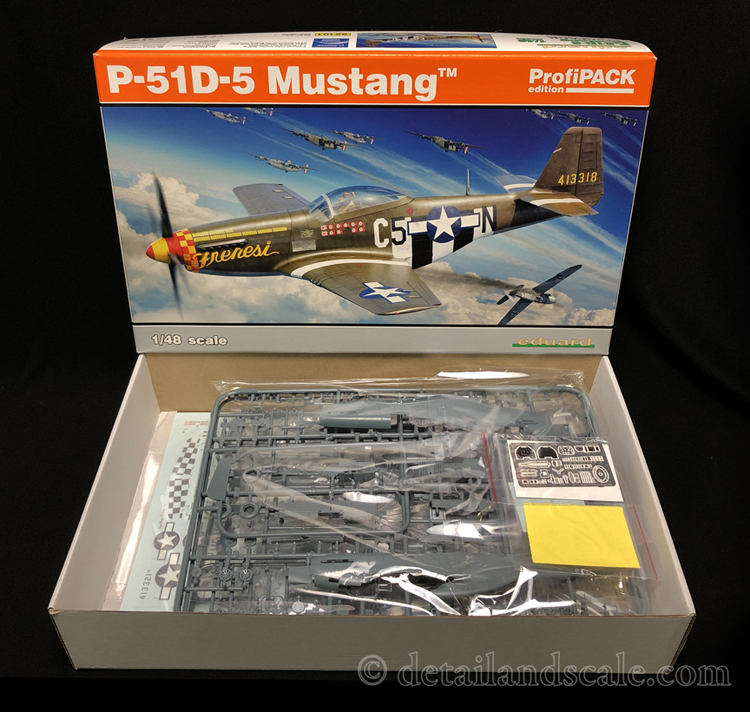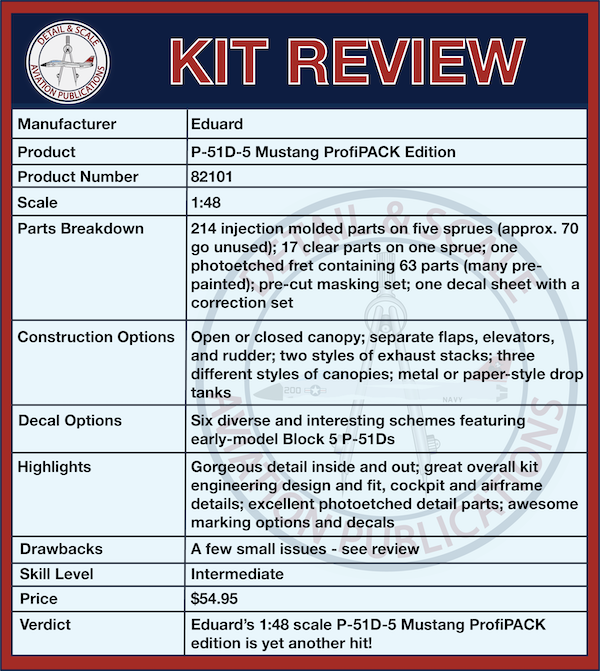Eduard P-51D-5 Mustang ProfiPACK Edition
1:48 Scale


The P-51 Mustang is one history’s most famous aircraft. It was the highest-scoring Allied aircraft of WWII and is one of the most widely produced and popular model kits of all time. Approximately 430 injection-molded kits of the P-51 have been released to date, from 1:144 to 1:24 scales. Nearly every plastic kit manufacturer has released a P-51 since 1951. In 2019, Eduard launched their long-anticipated family of 1:48 scale Mustangs with a Limited Edition release first available at the 2019 IPMS/USA Nationals. Here, we check out their P-51D-5 ProfiPACK edition.

he origins of the P-51 go back to early 1940. The U.K. was seeking a stopgap fighter to help hold the line against the German Luftwaffe. Great Britain’s Purchasing Commission approached North American Aviation to build Curtiss P-40s under license for the RAF. Instead, North American pitched an alternative. They argued they could build a new fighter that would be easier and faster to produce, and that would also outperform the P-40. The British accepted the offer and placed an order for 340 of the new aircraft in March 1940. On September 9th, a design team headed by NAA’s “Dutch” Kindelberger finished the prototype NA-73X airframe. It was a rapid developmental process by any standard, even during the war: a mere 102 days had passed between contract signature and roll-out.
The NA-73X first flew on 26 October. It featured a revolutionary laminar flow airfoil wing derived from NACA flight test data and an innovative under-fuselage ducted engine cooling system. Mustangs were very fast, maneuverable, and well-armed. Early versions entered production in May 1941 and went into combat with the RAF 11 months later. These were powered by Allison engines and were typically equipped with two .50-calibre nose-mounted and four .30-calibre wing-mounted machine guns. The 1,100hp Allison V-1710-39 powerplant provided impressive performance, but only up to about 15,000 feet. RAF Mustang Mark Is and IIs were soon followed by the improved P-51As, Bs, and Cs operated by the USAAF and the RAF. British experimentation with the supercharged Merlin powerplant’s provided for outstanding high-altitude performance, and by mid-1943, Packard-built Merlin engines became standard for new build P-51s.
The definitive P-51D variant was fitted with a Plexiglas bubble canopy providing excellent 360-degree visibility, and the aircraft could reach around 440 MPH while its service ceiling was just shy of 42,000 feet. Armament consisted of six wing-mounted .50-caliber machine guns while underwing pylons permitted the use of range-extending drop tanks, along with rockets and bombs. There were various production blocks and sub-variants of the P-51D. The first 100 P-51D-1s went to Australia, and then the next 1,000 airframes were P-51D-5s. The vertical stabilizer design of the P-51C was carried over, but in the new configuration, directional stability was compromised. The addition of a tail fillet solved the problem. The tail fillet became standard on the D-10 and all later production versions, though some D-5s at the Dallas factory were built with a tail fillet while some others were modified in the field.
During WWII, P-51s saw action in the European, North African, Mediterranean, and Pacific theaters. Mustangs claimed 4,950 air-to-air kills. In USAAF service, P-51Bs and Cs were used by the Eighth Air Force to escort bombers in raids over “Fortress Europe” beginning in 1943. The P-51D took over that role by mid-1944. Mustangs were used increasingly as ground attack aircraft as well. By the start of the Korean War, the Mustang had been re-designated F-51 and it served as the front-line fighter until the F-84 and F-86 arrived on the scene. The “Cadillac of the Skies” served with Air National Guard Units operated until 1957 and the last Mustang in USAF service was retired in 1978. In foreign service, the Dominican Republic retired its last operational P-51 in 1984. Today, a handful of P-51s fly as warbirds in the hands of private owners.

Eduard’s 1:48 scale P-51D-5 Mustang ProfiPACK Editionkit contains five injection-molded polystyrene sprues containing 214 parts (about 70 parts are not used in this version of the kit). Seventeen clear parts come on one clear sprue. This Limited Edition set also has 63 photoetched metal detail parts included on one fret (most of them are pre-painted). There’s also a pre-cut self-adhesive masking set and one decal sheet (along with one small decal correction insert). The full color instruction booklet organizes the build over 12 pages. Markings for six airplanes include:
- P-51D-5 44-13318 “Frenesi,” flown by Lt. Col. Thomas L. Hayes Jr., 364th FS, 357th FG, 8th AF, Leiston, England, June 1944
- P-51D-5 44-13606, “Louisiana Heatwave,” flown by Capt. Claude J. Crenshaw, 369th FS, 359th FG, 8th AF, East Wretham, England, September 1944
- P-51D-5 44-13859, flown by Lt. Walter Mullins, 55thFS, 20th FG, 8th AF, Kings Cliffe, England, September 1944
- P-51D-5 44-13321, “Devastating Dottie/Lady Janie VIII,” flown by Capt. John M. Simmons Jr., 317th FS, 325th FG, 15th AF, Lesina, Italy, August 1944
- P-51D-5 44-13321, “Cripes A Mighty 3rd” flown by Maj. George Preddy Jr., 487th FS, 352nd FG, 8th AF, Bodney, England, June 1944
- P-51D-5 44-13321, “Cripes A Mighty 3rd” Flown by Maj. George Preddy Jr., 487thFS, 352nd FG, 8th AF, Bodney, England, August 1944
Strengths: Over the last decade, Eduard has produced some truly superlative 1:48 scale injection-molded model kits, starting with their family of Spitfires, Bf 109s, Fw 190s, and now, their P-51D. As noted in earlier reviews, I think that Eduard can indeed claim “best 1:48 scale P-51D” with this kit.
All the good things I’ve described about the basic Eduard 1:48 scale Mustang in previous reviews (which you can read HERE) apply to this kit as well. To recap, however, surface details are very accurate. Eduard has nailed the relatively featureless wing surfaces while rivet/fastener details on the fuselage and tail surfaces are as exquisite as they are sublime. Test fitting of the fuselage halves and wings appears airtight. The only fit that seems not virtually seamless involves the upper wing roots. It looks a little fiddly, but I suspect that when all the assemblies come together, the fit should be far more stable.
Eduard’s P-51D-5 has a number of building options, including an open or closed canopy, separate landing flaps, ailerons, rudders, elevators, and radiator exhaust, two canopy styles, the single rear-view mirror, and shrouded or unshrouded exhaust stacks. Optional paper or metal-style external fuel tanks are also provided. Other building options found on the sprues which aren’t used in this issue of the kit include the uncuffed propeller, bombs, and rockets. In this kit, the details of the D-5 look very well represented from the early cockpit interior to the original P-51D tail (no fillet). Instead of different tail parts, Eduard found it easier to simply retool the entire left and right fuselage halves (Sprue C). And it works!
Moving onto the interior: the cockpit features separate frames for the sidewalls, a multi-part seat, and excellent representations of the radio, battery, and fuel tank, down to the separate parts for the wiring and fuel line. The really impressive elements here are the photoetched parts which add a great deal of detail and visually interesting features to the cockpit, such as the pre-painted instrument dial faces, the gorgeous pre-painted harnesses (complete with simulated stitching details), various placards, and the photoetched throttles, trim wheel, and other parts. In sum, the cockpit is a real knockout.
The main gear well builds up from about 16 parts, and it is very rich with detail, from the textures of the parts and ribs to the fuel lines and pump details. All that’s missing are the smaller hydraulic and electrical lines, and the builder can add those relatively easily if they wish. There’s also a fully enclosed tail wheel well that looks excellent. Another nice feature is a single-piece gun port section on each wing. Unlike the Tamiya kit, for example, the gun barrels do not assemble out of upper and lower halves resulting in some tricky/ugly seam work. Eduard’s engineering approach here is excellent. Also note that on the interior of the wings, there’s a blanking plate on the inside of each wing so that shell ejection ports do not open up into the deep, hollow inside of the wing for all to see.
The masking set will save a lot of time with masking the wheel hubs and a few airframe access panels. The exhaust stacks are great, and even though they are injection-molded, the ends are nicely hollowed-out. Here, there’s no need for a cast resin replacement set. The clear parts look fantastic, and the windscreen has a great extended fairing around it so gluing, masking, and painting will be a very low-risk affair.
The markings options are awesome. Eduard really knows how to capture some colorful, eye-catching, and compelling schemes. There’s a good chance you’ll have a hard time choosing one. “Louisiana Heat Wave” and “Devasting Dottie/Lady Janie VIII” both have some great color. “Frenesi” captures well the Mustang in its olive drab-over-gray ETO camouflage, and the flying pin-up girl nose art scheme of the Mustang flown by Walter Mullins combines the natural metal and olive drab camo. At least for me, the two schemes for George Preddy Jr.’s “Cripes a’Mighty 3rd” are very historic and poignant, and capture his airplane’s markings during and after D-Day. The decals include one large sheet that has a very comprehensive stencil set for the airframe, gear, wheels, prop blades, and drop tanks, and a small correction set, both printed by in-house by Eduard, and they all look great. I can see no technical errors in printing. There’s also a very valuable painting guide highlighting where natural metal versus aluminum lacquer-painted surfaces are found on silver P-51s.
Weaknesses: I cannot offer any substantive critiques of this kit. One minor issue for some folks is that if PE parts aren’t your cup of tea, the detail on the pilot’s instrument panel is really minimal. The idea is to either use the PE parts or kit supplied instrument panel decals. Detail painters have little to work with. Note that if you want to position the ailerons, rudder, and elevators in anything but the neutral position, you’ll need to remove their mounting tabs. Also be really careful with the thin plastic strip that separates the left and right wheel wells on the lower wing half (Part B-15). It is pretty fragile, and in some kits, it is warped/bent inward because it is so fine. My sample is unaffected by this issue, but if that’s a problem in the kit you have, just note it will go back to its proper shape when the gear well assembly is fitted.

Eduard continues on with their excellent line of 1:48 scale Mustangs with this P-51D-5. The kit offers a great combination of detail, accuracy, and pure allure that is really hard to beat. Future reviews that we’ve lined up will look at Eduard’s Royal Class Boxing and a ton of aftermarket superdetail sets that have already been released. Stay tuned!
Sincere thanks are owed to Eduard for the review sample. You can visit them on the web at http://www.eduard.com and on Facebook at https://www.facebook.com/EduardCompany
Haagen Klaus
Scale Modeling News & Reviews Editor
Detail & Scale


